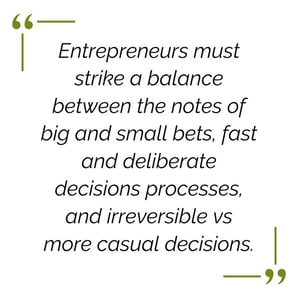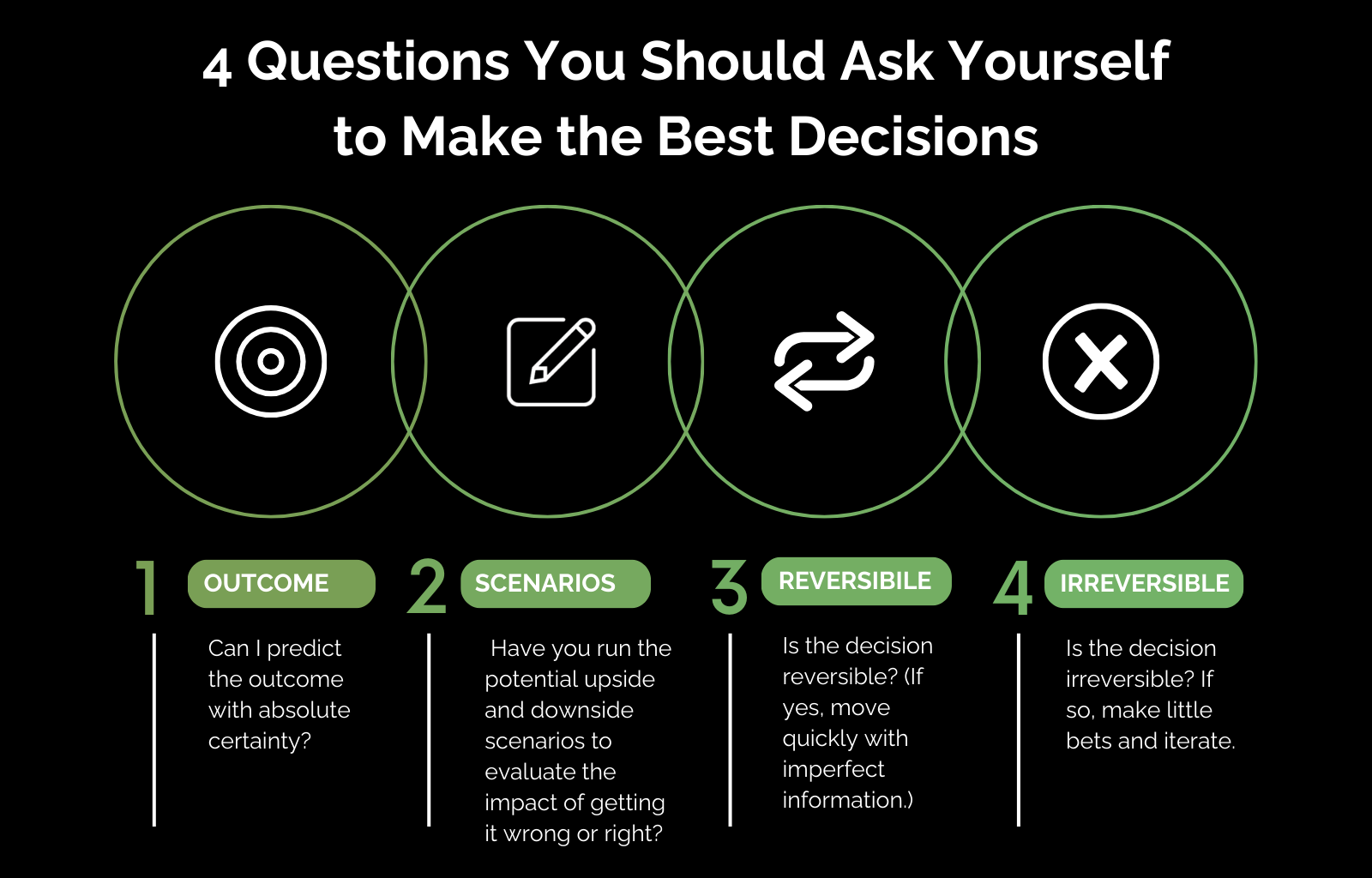There is no shortage of writing on business philosophy; a fact I’m painfully aware of as I write this. So, while I’m hesitant to claim that I have a universally successful formula for starting and scaling a business, I do have several frameworks and processes that helped me throughout my career.
One of the largest contributors to failure for growth-stage businesses is slow decision making. Waiting for more information can be costly, and with limited capital, can prove crippling. To be clear, slow decision making isn’t to be confused with poor decision making, which can also result in significant challenges. Mastering this balance and dynamic can be the difference between success and failure. As such, the ability as a leader to make tough decisions in the face of pressure and limited information is a critical skill to develop. 
A few frameworks I’ve found to be exceptionally helpful are “Reversible and Irreversible Decisions" and "Thinking in Bets.” Personally, I find myself combining them when I am at a crossroads and face a decision. Combining these approaches provides structure while relieving risk and pressure.
Reversible and Irreversible Decisions
Tech leaders, such as Jeff Bezos, have long cited a framework that can be a key ingredient in strong decision-making: the spectrum of reversibility. When faced with a challenge, this framework encourages you to position the fundamental dynamics on a spectrum of reversibility.
At one end of the spectrum are Type 1 decisions: the highly consequential, nearly irreversible, immediately prioritized choices. Once you start down the path of a Type 1 decision, unwinding it can be difficult and costly. These demand careful consideration, methodical analysis, and wide consultation with stakeholders.
For example, a decision to take investment and sell 30% of your company or even committing to a 5-year expanded office space.
On the other end of the spectrum are easily reversible Type 2 decisions. These are fluid, dynamic, and ultimately, less costly choices. Type 2 decisions can be made quickly and efficiently, often by individuals or small groups with necessary expertise.
For example, implementing a new sales process, or engaging a new channel partner.
Acting reflexively is essential to seize opportunities and avoid the pitfalls of indecision. The key to mastering this approach lies in understanding where each choice falls on the reversibility spectrum as indicated by cost (capital, resources, time) of undoing a decision. The higher the cost, the more irreversible the decision (Type 1). Alternatively, if the cost of reversal is relatively low, the decision is more easily classified as reversible (Type 2).
While this initial framework is useful, the question remains - how can one make difficult, irreversible decisions more nimbly or with less risk? Many seemingly daunting decisions can be broken down into “little bets” that, even if wrong, unlock new information that allows for further progress and the next “little bet” to move forward.
Breaking Big, Irreversible Decisions into “Little Bets”
We are accustomed to associating crucial business choices with high stakes and substantial risks. Peter Sims' book, Little Bets: How Breakthrough Ideas Emerge from Small Discoveries contains some interesting lessons, especially when combined with the concepts above.
The main principle behind "Little Bets" is the power of focused experiments when facing large, weighty (Type 1) business decisions. Rather than committing all your resources to a single overwhelming project, this approach allows business leaders to test their ideas with limited risk and financial commitment.
First, we must embrace the fact that some degree of “failure” is unavoidable and simply part of growth and learning. Finding ways to break up large Type 1 decisions into small bets offers the flexibility to experience failure on a small scale, helping you gather valuable insights, adjust your approach, and fine-tune your strategy. This iterative method is a good way to refine your strategic decisions and improve outcomes.
Alliance in the Face of Adversity
During my time at Comcast, I was tasked with identifying, establishing, and accelerating new lines of business. One such business, its creation largely a function of big decisions being turned into little bets, was Xfinity Signature Support. In 2011, customers' in-home connectivity needs were rapidly growing and the avalanche of personal device technology on which we now rely was just beginning to descend on the American consumer landscape. Households were quickly shifting from a single computer to multiple personal devices, such as laptops, tablets, and gaming consoles. Most interesting was that according to a 2010 survey by Parks Associates, more than 50% of Americans with Internet service looked to their broadband provider as their first or second choice to solving their home computer-related technical issues.
The survey also showed that 75% of users preferred to receive all technical support services from a single vendor. In response to these shifts, we created Signature Support, a service to provide access to knowledgeable and experienced IT specialists, who could provide on-demand supplementary technical support (online, over the phone, or in the home). Assistance was available either as a monthly subscription add-on, or on a stand-alone basis for one-time fixes, such as virus removal or connecting devices (like printers or game consoles) to wireless networks. Xfinity Signature Support was going to deliver an end-to-end exceptional customer experience, while building loyalty in our customer base in an increasingly competitive broadband market.
Building this business would take significant investment and risk, but I was confident the investment could be sold given the size of the addressable market and Comcast's ability to win outsized share. To make this work, we needed to build out an expert team... in an emerging market... with no prior internal skillset or structures to support the solution. Building quickly to take advantage of that moment in time was imperative. It was also dauting; especially knowing that, like every other service-based business, we likely weren't going to get it right the first time.
In the face of these factors, partner (vs. build or buy) became the path. It was a smaller bet - in the hundreds of thousands, vs. millions - that would allow us to test the market, test the model, and refine the kind of team we needed. We partnered with three excellent companies that cohesively provided the backbone of in-home and remote technical support. Though these teams had not worked together prior, they were motivated by the expanded business and the opportunity to transform the consumer tech support landscape.
To enable this integrated partner approach, we gave up ~ 35% of our gross margins, but our upfront investment was far lower, a third of what would have been spent to build our own solution. We had a clear expectation that we were likely to in-source some (if not all) of the capabilities as the business grew. In this instance, it made sense to accept smaller margins in exchange for a smaller investment for the sake of seeing whether this business was worth further investment.
In retrospect, this was the right approach. The in-home consumer device market did, of course, continue to grow. However, as consumers advanced their own knowledge of devices and connectivity, the appetite for on-demand remote services wasn't big enough to invest in for the long term. Further, we learned that while the service received top ratings, tying it to broadband service created confusion in the billing and payments department. As such, we made the tough decision to unwind this business and use our learnings to inform company-wide support decisions with little impact to the larger enterprise.
Uncertainty is a constant. However, by making small, focused bets, you can navigate the complexities of strategic decision-making without the impact of colossal failures. This approach provides the freedom to explore and adapt while maintaining a clear strategic direction. Next time, you're confronted with a significant, perhaps even irreversible, business decision, consider making a small wager and use that outcome to inform the next little bet. That string of decisions will guide you toward strategic innovation and success.
Decision Making as a Competitive Edge
Growth-stage companies often outpace established competitors due to their agility, ability to move quickly, and disrupt established business models. Waiting for more information can be a risk in and of itself when compared to acting decisively at 70% certainty and adjusting as needed.
While some choices demand swift and decisive action, others require patience and calculated assessment. This blend of reversible and irreversible decisions, coupled with thinking in proportionate positions and wagers, creates a dynamic framework for navigating the uncertain terrain of entrepreneurship.

When you find yourself at the crossroads of a decision, prioritize the things that matter most.
- Acknowledge that we can't predict outcomes with absolute certainty.
- Size the impact of getting it wrong and getting it right.
- If this is a reversible decision, move quickly even with imperfect information.
- If irreversible, create optionality or little bets to reveal more info. Iterate.
- Scenario plan to assess the expected value of the upside and downside and model with sensitivity analysis.
Embracing this nuanced approach, learning to think in probabilities, breaking decisions into small wagers and distinguishing between reversible and irreversible investments will not only improve decision making for you and your teams, but also make you a better leader. Continually enhance your decision-making skills and use every outcome as a lesson. By weaving these concepts into the fabric of your entrepreneurial and leadership journey, you'll be better equipped to thrive in an ever-changing business landscape, defined by constantly evolving unknowns and a steady stream of seemingly crucial decisions.
About Dan
Daniel Herscovici is an Investor and Partner at Edison Partners. Over the coming months, he will share personal learnings from more than two decades in the technology and investment industries. His professional experience spans several technology horizons including the early days of mobile, the accelerated expansion of high-speed internet, and the introduction of Wi-Fi to consumer households. Dan co-founded and led several businesses at Comcast, including Xfinity Home and Signature Support. He also served as interim CEO of Zagster, a bike-sharing company acquired by Superpedestrian in 2020. Dan’s passion for solving tangible market problems, delivering customer-first products, and finding innovative ways to address unmet or unarticulated market needs is unmatched. His stories and advice will inspire and inform you of what it takes to both build and scale businesses.


